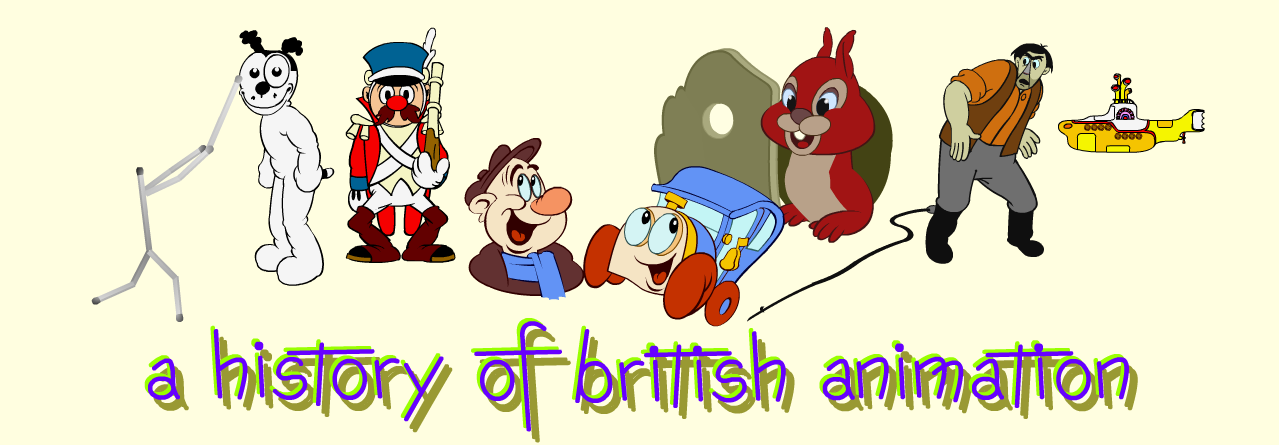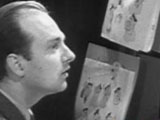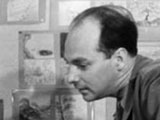

|
 | Harold F Mack(1918-1975) |  |
||
|
Harold Frederick Mack was born in Islington on the 6th of March 1918, a late arrival to the family of Thomas and Alice Mack that already consisted of two sons and a daughter. Thomas, according to Harold's birth certificate and his own death certificate, was a coach painter - although Harold, on his marriage cetificate, chose to give his father's profession as "Clerk in Holy Orders", ie clergyman. Encouraged by an elder brother, Harold won a scholarship to study art at Harrow Polytechnic, then started work in the art department of the Gordon Lawrence adverising agency. Here he first met John Halas, who rented space in the same building. Harold moved to Lord & Thomas, then one of the largest agencies, but with the outbreak of World War II the company had to downsize, and in 1940 he was laid off. Halas and his partner Joy Batchelor had just been sponsored by J Walter Thompson to set up their own studio, and offered Mack (as he became known) a job with them. The first films they made for J Walter Thompson were advertising cartoons for Kellogg's cornflakes (Train Trouble) and Lux soap flakes (Carnival in the Clothes Cupboard). In 1943 the ACT (the ciné technicians union) reached an agreement with Publicity Pictures on rates of pay for the "Cartoon, Diagram and Rostrum Camera Section", an area of filmmaking which had not previously been "organised". According to animator Jenny Reyn, Mack agitated for the staff at Halas & Batchelor, about 6 animators at the time, to join the union and strike for union pay rates. After a meeting with ACT Halas decided they should all join the union, and in the summer of 1944 the ACT proudly announced their first ever "Closed Shop" agreement. Mack left Halas & Batchelor in 1944 to join the newly formed Gaumont-British Animation unit, then housed in Soho Square. David Hand, previously second-in-command at Walt Disney Studios, had been hired by J Arthur Rank to create a Hollywood-style animation studio, and brought over ex-Disney employees John Reed, Ralph Wright and Ray Patterson to train the staff. Mack learned Disney animation practises, while working on cinema commercials and preparation for the Animaland entertainment shorts. But after a couple of years Mack tired of the 'factory' approach, feeling he did not have enough personal input. Learning that another American, ex-Fleischer animator George Moreno, was starting a smaller-scale studio to make entertainment shorts he left Gaumont-British Animation in the summer of 1946 to join British Animated Productions. George directed the first Bubble & Squeek film (The Big City) himself, with Mack as the chief animator, while the staff learned, or adapted to, George's methods on the job: on subsequent films Mack was the directing animator. But Mack was not happy with George's way of working, nor British Animated Productions' precarious financial situation, and decided to quit on completion of the fourth film, Home Sweet Home. He and Pamela French were engaged to be married, and they planned to set up their own unit. They left towards the end of 1948, along with Hugh Gladwish and Claud Lipscombe, and Mack submitted the following entry for the Studios and Production Units section of the Kinematograph Year Book for 1949 (to run for two years): MACK CARTOON UNIT. 17, Boxmoor Road, Kenton, Middle- sex. Tel. : Wordsworth 2233. Director and Chief Animator : Harold F. Mack. Animation : Hugh Gladwish, Pamela French. Music Composer and Director : Jose Norman. Art Director : Claude A. Lipscombe Type of Production : Entertain- ment, instructional and advertising cartoons.
While Hugh and Claude turned to other animation studios to find work, Mack was presumably looking for animated advertising or public information film productions. The National Savings Committee had commissioned an animated advertising film from Pinschewer Films Ltd, based on the white elephant that had featured in a popular poster campaign ("If you don't need it - don't buy it!"). I think that Mack may have approached Pinschewer in the hope of persuading them to hire his unit to provide the animation. Pinschewer Films Ltd was the London sales office of Pinschewer Film-Atelier, of Bern, Switzerland, a studio that specialised in advertising cartoons. All production work was carried out by the Berne studio, and Pinschewer would not have been prepared to make any exceptions, but it seems they were prepared to offer Mack the opportunity to work on the film in Switzerland. Julius Pinschewer was a German who had pioneered the advertising cartoon in Europe, so this was a great opportunity to observe his methods. Mack may also have thought that the trip to Bern could double as a honeymoon - he and Pamela married on 26th January 1949, and they travelled to Pinschewer Film-Atelier in the early part of 1949, to work on Willie Does His Stuff, with Pamela employed as Mack's assistant and inbetweener. There is a "making of" film, Willie Comes to Life, made by Pinschewer Films, which shows Mack and Pamela at work, presumably at Bern. It was apparently shown in the UK as a further promotional film for National Savings, though of course it also promotes Pinschewer Films, and, to a degree, Harold Mack. The question arises as to whose idea it was to make it. Mack had previously featured in a Pathé newsreel item on the making of a Bubble & Squeek film at British Animated Productions, made to promote the series that Pathé were about to distribute. It was a fictional reconstruction, made 16 months after the short in question, Fun Fair, had been completed. Willie Does His Stuff seems to have been completed by the summer of 1949, and Pamela and Mack prepared to return home. They would already have known of the Dutch comics artist Marten Toonder from a couple of his strips that ran in British newspapers, but it may have been while at Bern that they learned of his plans to rebuild the animation side of his studio, which had previously been concentrating on its output of comic strips. The studio had been making a series of advertising films, mainly for Philips Radios, featuring his strip characters Tom Puss and Mr Bumble (Tom Poes en heer Bommel in the original Dutch) directed/animated by Henk Kabos, and Toonder was planning to make a feature-length cartoon, Fortune Fair, starring these, his most widely syndicated characters. Mack contacted Toonder, and it is possible that the Macks visited Toonder Studio's (the inappropriate apostrophe is part of the registered name) on their way back from Switzerland. Mack's interest was most timely for Marten Toonder. As Jan-Willem de Vries explains in his book on the Toonder Animation Studio's, government finance for the feature film, on which Toonder was counting, had failed to materialise, leaving Toonder out of pocket. Disillusioned, Kabos had decided to return to Joop Geesink's stop-motion animation studio, along with his animation team. Now here was an experienced directing animator, Disney-trained by David Hand, and able to call on a team of British animators. Toonder was still pursuing other funding options for his feature. If he had Mack on board the project could still go ahead. Toonder offered Mack a job as animating director for Toonder Studio's, to work on existing projects and build the studio back up into a position to embark on the feature. It was a big step, and the Macks gave it careful consideration. Mindful of his experiences with George Moreno, Mack contacted the Dutch Ministry to verify that Toonder's plans were viable. Reassured, he accepted Toonder's offer. In an attempt to keep the animation department going, Toonder had embarked on a series of 'television strips' - 8-minute black & white films, based on stories from the Toonder comic strips - for test transmission on Philips' experimental television system. The budget for these was low, so the animation had to be very limited. Kabos' team had completed the first (Floepedorus de flessengeest) before they left, and a second (The Legend of Loch Ness) was being prepared by the comics artists, using rendered drawings with some cut-out animation under the direction of the animation cameraman, John van der Meulen . Mack's first task was to take over direction of The Legend of Loch Ness, adding a few animated touches. The cut-out drawings looked rather old-fashioned and Mack was sure better-looking limited-animation could be done as economically with cels. He directed and animated the next television strip, Plucky Panda's Penny, reusing the same handful of animated actions throughout. Although still very stilted, the film was an improvement on The Legend of Loch Ness, which appears to have been held back and released later. [Unlike Floepedorus de flessengeest, which was in Dutch, The Legend of Loch Ness and Plucky Panda's Penny were produced in English. Perhaps Mack hoped to get them released in the UK through his own contacts. The version of Plucky Panda's Penny that I have seen has a music and sound effects track only, without the narration track that it clearly requires. The Legend of Loch Ness, however, is complete with an English narration. The narrator reminded me of Oliver Postgate. but his son Daniel assures me that although there is certainly an uncanny similarity at certain points in the narration, the voice isn't Oliver's.] But Toonder Studio's wished to be producing quality animation. Mack and Pamela produced cel set-ups for publicity purposes while Marten Toonder looked for advertising work. Harold F and Pamela Mack are named on the electoral roll at their Hampstead address for the years 1949, 1950 and 1951. This would seem to mean that when the form requiring the information for the 1951 roll arrived through the door, which would have been during the summer of 1950, the Macks had not yet committed themselves to moving to Amsterdam on a permanent basis. Toonder had secured 2 sponsored film commissions, Theodora's Testament and The Next Chapter. The first, an agricultural information film, alternated animated sequences featuring Theodora the cow with live-action footage and the second, a propaganda film for the world Federalist movement, included animation, live-action and stop-frame techniques. Both films were scripted by Marten's brother, author and poet Jan Gerhard Toonder and during production they discussed making a short, poetic entertainment film. It may well have been Toonder's willingness to produce this film, The Golden Fish, that decided the Macks that their future lay with this studio. They left London, to live on a houseboat in Amsterdam. The Golden Fish made a huge financial loss, but brought critical acclaim and prestige to the Studio and attracted more sponsored work. On the strength of her design work on the film Pamela, who had previously just been Mack's assistant animator, was given the job of colour styling Toonder Studio's productions. In 1952 Danish animators Børge Ring and Bjørn Frank Jensen joined Toonder Studio's. Børge Ring recalls Mack criticing their work: "You think you are emulating Disney, but your stuff looks more like Fleischer. Because you are not able to see the amount of draftsmanship that goes into Disney's animation." Familiar with both approaches after working for Hand and Moreno, Mack was well aware of the difference made by good basic drawing. All three men were keen to improve their work and experiment with new ideas, and the studio benefitted from their enthusiasm. Toonder Studio's was selected to make a series of six cartoons sponsored by the Marshall Plan for the re-education of post-war Germany. Designed by the avant-garde US animator Philip Stapp, then based in Paris as executive producer for the Economic Cooperation Administration, the films were directed by Mack and featured circus clown Hugo, who learns to co-operate with the other circus acts. The studio made TV commercials for UK and Germany, as well as a few more of their own productions. The proposed feature, Fortune Fair, was never put into production. As the animation unit evolved its own, more graphic style Marten Toonder's interest in animation faded and he returned to concentrating on his comic strip work. Most of the UK assignments were through Harold Mack's contacts, and in 1958 he and Pamela decided to set up their own production company. The Anglo Dutch Group was based in Amstelveen, a suburb of Amsterdam, where Mack made a string of award-winning commercials and trained up a new generation of Dutch animators. Harold Mack was diagnosed with cancer in late 1975, and died on December 24, at the age of 57. His last animation project was incorporated into a live-action framework by former friends and colleagues in 1976. Entitled High as a Kite, it concerns a dying man's musings. [Many thanks to Jan-Willem de Vries for his help in compiling this biography.] |
Filmography(There is disagreement between sources on the dating of Halas & Batchelor films. This would seem to be down | ||||
| Train Trouble | (Halas & Batchelor, 1940) Animator | |||
| Carnival in the Clothes Cupboard | (Halas & Batchelor, 1940) Animator | |||
| Abu's Dungeon | (Halas & Batchelor, 1943) Animator | |||
| Abu's Poisoned Well | (Halas & Batchelor, 1943) Animator | |||
| various advertising films | (Gaumont-British Animation, 1944-6) Animator | |||
| The Big City | (British Animated Productions, 1946) Animator | |||
| Fun Fair | (British Animated Productions, 1947) Director | |||
| The Old Manor House | (British Animated Productions, 1948) Director | |||
| Home Sweet Home | (British Animated Productions, 1948) Director | |||
| Willie Does His Stuff | (Pinschewer Films, 1949) Animator | |||
| Plucky Panda's Penny | (Toonder Studios, 1949) Director | |||
| The Legend of Loch Ness | (Toonder Studios, 1950) Director | |||
| Theodora's Testament | (Toonder Studios, 1951) Co-Director | |||
| The Next Chapter | (Toonder Studios, 1951) Director | |||
| The Golden Fish | (Toonder Studios, 1952) Director | |||
| Hugo macht Musik | (Toonder Studios, 1952) Director | |||
| Hugo am Trapez | (Toonder Studios, 1952) Director | |||
| Hugo baut auf | (Toonder Studios, 1952) Director | |||
| Hugo als Kleingärtner | (Toonder Studios, 1952) Director | |||
| Hugo als Kraftmax | (Toonder Studios, 1952) Director | |||
| Hugo als dompteur | (Toonder Studios, 1952) Director | |||
| Moonglow | (Toonder Studios, 1954) Director | |||
| Firestone tyres commercial: The Professionals | (Anglo Dutch Group, 1969) Director | |||
| 7-Up commercial: Hippies | (Anglo Dutch Group, 1974) Director | |||
| 7-Up commercial: Eunuch | (Anglo Dutch Group, 1974) Director | |||
| 7-Up commercial: Kameleons | (Anglo Dutch Group, 1974) Director | |||
| 7-Up commercial: Wijs de weg | (Anglo Dutch Group, 1974) Director | |||
| High as a Kite | (Anglo Dutch Group/Mighty Movie Company, 1976) Animator | |||
Links to Other SitesHarold Mack animator: biography by Dutch author Jan-Willem de Vries. BFI Player: video of Willie Does His Stuff (1948): Directed for Pinschewer Films by Harold Mack. |
Peter Hale
Last updated 2017
|